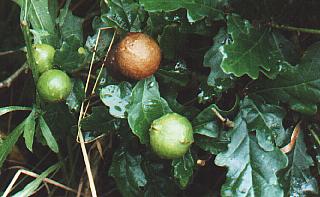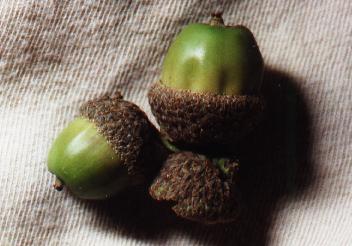
 |
|
| QUODITCH EDUCATION DEVON |
|
|
|
SESSILE or DURMAST OAK Quercus petraea (Fagaceae) |
|
|
|
"As long as the Lion holds his fabled place as the king of beasts, and the eagle as king of birds, the sovereignty of British Trees must remain to the Oak. In truth he is a kingly tree, the emlem of majesty, strength and durability." So wrote The Reverend C.A. Johns at the end of the nineteenth century. There are two native British oaks The pedunculate Oak ( Quercus ) and the Sessile or Durmast oak ( Quercus petraea). Our at Quoditch are Sessile Oaks ( How to tell the difference) At
one time, because of its strength oak was used to build ships ("Hearts
of Oak are our ships, jolly tars are our men"). Most of the oak for the
ships came from the Forest of Dean in West Gloucestershire. |
|
Name origins Derives its name from Old Enlish "ac",old norse "eik", German " eiche" latin "quercus" an oak. Shape, Height, Bark, Leaves History, Uses Tannin , feeding pigs, erzatz coffee, used in some countries as food by the early greks being able to be stored away in Winter. Practical Herbal Mythology and tradition . The greeks believed that the Oak was the first tree. The many mentions of the Oak in th eBible probaly refer to the Evergreen oak ( Quercus Ilex). Baal, the god of the Canaanites is considered to be identical to the Roman Saturn, the Celtic Yiaoul and the British Yule. The Druids celebrated Yule-tide under the form of an Oak . They professed to maintain perpetual fire and every year the fires belonging to the people were extinguished and relighted from the sacred fire of the Druids. Hence the Yule-log. Until recently, it was a Devon tradition to light a fresh log on the fire but to take it off before it was consumed and reserve it to kindle the Christmas fire next year.( Johns)( Sometimes an Ash-log was used - hence the Devon tradition of the Ashen faggot (See wassailing)) Oak trees can live for many years and are often connected with major events. It is said that King Charles hid in the boughs of an oak tree when he was pursued by the Roundheads. ( in Shropshire) At Tamerton Foliot, near Plymouth, an old tree in the centre of the village is known as the Coplestone Oak. It is said that, at this spot,the Lord of the Manor, Christopher Coplestone, lost his temper with his godson and stabbed him to death. Ther is an old Druidic belief that oaks are sacred and possess special powers. It was said that if you carried an acorn in your pocket all the time you would remain looking youthful. |
|
|
|

|
Sometimes the leaves develop growths,known as "galls" or "oak apples". These are a reaction to a gallwasp ( of the Cynipidae family) laying its eggs in the leaf. At one time gallic acid was extracted from these galls and was used in the manufacture of ink. |
|
|
|
 |
The seeds of the oak are named acorns |
| There is a well-known folk song dedicated to the Oak.
One version was written in America in 1837 byHenry Fothergill Chorley. But this English version was collected by the well known colector Alfred Williams from Thomas Larkin of Shrivenham, Berks 1. Chorus 2.
|
| How to tell the difference between pedunculate and sessile oaks | |||||||||||||||||||||||||
|
|||||||||||||||||||||||||
|
Other types found in the UK |
|||||||||||||||||||||||||
|
|||||||||||||||||||||||||